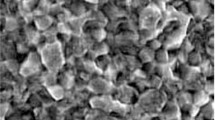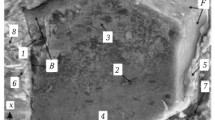Abstract
Characteristic morphologies of the surface of oxide ceramics, which are produced by grinding, have been identified and a relationship between conditions of diamond grinding and these morphologies has been revealed using the developed method of study. It has been found that the type of the characteristic morphology of the surface of ground oxide-ceramic specimens has a strong effect on the tribological behavior of these specimens. The prime role of the grinding subsystem, which is a component of the manufacturing system for producing ceramic friction members, in the formation of the mode of wear at the run-in stage has been established.
Similar content being viewed by others
References
Medvedovski, E., Wear-resistant engineering ceramics, Wear, 2001, vol. 249, pp. 821–828.
Grigor’ev, S.N. and Krasnovskii, A.N, Study of the triboengineering characteristics of ultradispersed composite power materials, J. Frict. Wear, 2011, vol. 32, no. 3, pp. 164–166.
Koji, K. and Koshi, A., Wear of advanced ceramics, Wear, 2002, vol. 253, pp. 1097–1104.
Min-Soo, Suh., Young-Hun, Chae., and Seock-Sam, Kim., Friction and wear behavior of structural ceramics sliding against zirconia, Wear, 2008, vol. 264, pp. 800–806.
Yang, C. and Bahadur, S., Friction and wear behavior of alumina-based ceramics in dry and lubricated sliding against tool steel, Wear, 1992, vol. 157, pp. 263–277.
Shuzo, K. and Yoshiteru, Y., Effect of surface texturing on friction reduction between ceramic and steel materials under lubricated sliding contact, Wear, 2003, vol. 254, pp. 356–363.
Tuersley, I.P., Jawaid, A., and Pashby, I.R., Review: Various methods of machining advanced ceramic materials, J. Mater. Process. Technol, 1994, vol. 42, pp. 377–390.
Kuzin, V.V., Fedorov, S.Yu., and Fedorov, M.Yu., Contact processes by cutting by ceramic tools, Vestnik MGTU “Stankin”, 2010, no. 4 (12), pp. 85–94.
Mochida, M., Suzuki, H., and Shimamune, T., Effects of grinding conditions on the ground surface aspects of fine ceramics (1st report). forming mechanism of ground surface in case of SiC, Si3N4 and Al2O3, J. Japan Soc. Prec. Eng., 1991, vol. 57, no. 2, pp. 304–309.
Kuzin, V., Grigoriev, S., Fedorov, S.Yu., and Fedorov, M.Yu., Surface defects formation in grinding of silicon nitride ceramics, Appl. Mechan. Mater., 2015, vol. 752–753, pp. 402–406.
Yakovlev, M.G., Gorelov, V.A., Fadin, D.M., and Merkulova, N.S., Transition to new technologies of processing of responsible details a turbo shaft engine by means of an estimation of a condition of a blanket of a product, Vestn. MGTU “Stankin”, 2012, no. 1 (19), pp. 28–31.
Author information
Authors and Affiliations
Corresponding author
Additional information
Original Russian Text © V.V. Kuzin, S.Yu. Fedorov, A.E. Seleznev, 2016, published in Trenie i Iznos, 2016, Vol. 37, No. 4, pp. 475–481.
About this article
Cite this article
Kuzin, V.V., Fedorov, S.Y. & Seleznev, A.E. Effect of conditions of diamond grinding on tribological behavior of alumina-based ceramics. J. Frict. Wear 37, 371–376 (2016). https://doi.org/10.3103/S1068366616040097
Received:
Published:
Issue Date:
DOI: https://doi.org/10.3103/S1068366616040097




